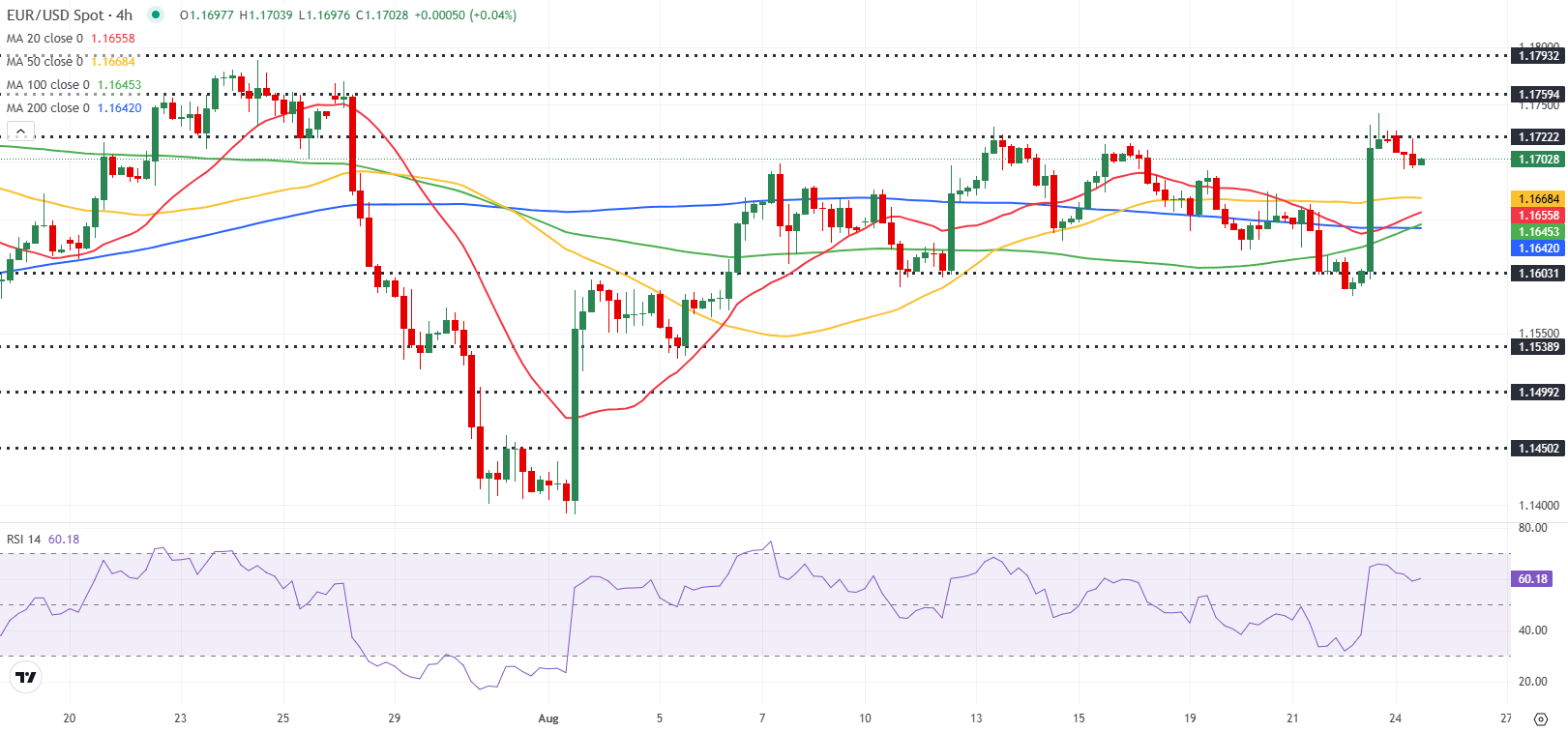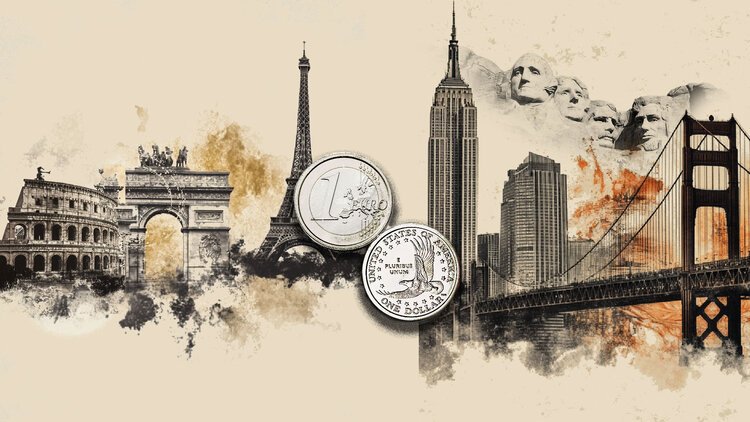- EUR/USD trades at around 1.1700 in the European session on Monday.
- Fed Chair Powell’s dovish remarks triggered a USD selloff on Friday.
- The pair’s near-term technical outlook suggests that the bullish bias remains intact.
EUR/USD gained 1% on Friday and touched its highest level since late July near 1.1750. The pair corrects lower to start the new week and trades at around 1.1700.
Euro Price Last 7 Days
The table below shows the percentage change of Euro (EUR) against listed major currencies last 7 days. Euro was the strongest against the New Zealand Dollar.
| USD | EUR | GBP | JPY | CAD | AUD | NZD | CHF | |
|---|---|---|---|---|---|---|---|---|
| USD | 0.10% | 0.35% | 0.07% | 0.10% | 0.23% | 0.94% | -0.39% | |
| EUR | -0.10% | 0.25% | -0.02% | -0.01% | 0.14% | 0.81% | -0.49% | |
| GBP | -0.35% | -0.25% | -0.36% | -0.25% | -0.10% | 0.56% | -0.78% | |
| JPY | -0.07% | 0.02% | 0.36% | 0.03% | 0.16% | 0.88% | -0.48% | |
| CAD | -0.10% | 0.01% | 0.25% | -0.03% | 0.11% | 0.85% | -0.52% | |
| AUD | -0.23% | -0.14% | 0.10% | -0.16% | -0.11% | 0.66% | -0.67% | |
| NZD | -0.94% | -0.81% | -0.56% | -0.88% | -0.85% | -0.66% | -1.36% | |
| CHF | 0.39% | 0.49% | 0.78% | 0.48% | 0.52% | 0.67% | 1.36% |
The heat map shows percentage changes of major currencies against each other. The base currency is picked from the left column, while the quote currency is picked from the top row. For example, if you pick the Euro from the left column and move along the horizontal line to the US Dollar, the percentage change displayed in the box will represent EUR (base)/USD (quote).
The US Dollar (USD) came under heavy selling pressure heading into the weekend and fuelled EUR/USD’s rally.
While delivering a speech on “Economic Outlook and Framework Review” at the annual Jackson Hole Economic Symposium on Friday, Federal Reserve (Fed) Chair Jerome Powell announced that they will adopt a new policy framework of flexible inflation targeting and eliminate ‘makeup’ strategy for inflation.
Commenting on the economic outlook, Powell acknowledged that downside risks to the labor market were rising and added that inflation effects of tariffs could be short-lived. The USD Index turned south and fell nearly 1% on Friday, reflecting the broad-based USD weakness.
On Monday, the data from Germany showed that the German IFO Business Climate Index rose to 89 in August from 88.6 in July, beating the market forecast of 88.6. On a negative note, the Current Economic Assessment Index edged lower to 86.4 from 86.5. Finally, the Expectations Index climbed to 91.6 from 90.7 in this period. These mixed figures don’t seem to be having a noticeable impact on the Euro’s valuation.
In the second half of the day, July New Home Sales will be the only data featured in the US economic calendar. In the meantime, US stock index futures lose between 0.1% and 0.2% in the early European session.
In case markets remain risk-averse in the second half of the day, EUR/USD could find it difficult to regain its traction. On the other hand, an improving risk mood is likely to weigh on the USD and open the door for another leg higher in the pair.
EUR/USD Technical Analysis

The Relative Strength Index (RSI) indicator on the 4-hour chart stays slightly above 60 and EUR/USD trades comfortably above the 20-period, 50-period, 100-period and the 200-period Simple Moving Averages (SMAs), highlighting a bullish stance in the near term.
On the upside, 1.1720 (static level) aligns as the immediate resistance level before 1.1760 (static level) and 1.1790-1.1800 (static level, round level). Looking south, support levels could be spotted at 1.1670 (50-period SMA), 1.1640 (100-period SMA, 200-period SMA) and 1.1600 (static level, round level).
Euro FAQs
The Euro is the currency for the 19 European Union countries that belong to the Eurozone. It is the second most heavily traded currency in the world behind the US Dollar. In 2022, it accounted for 31% of all foreign exchange transactions, with an average daily turnover of over $2.2 trillion a day.
EUR/USD is the most heavily traded currency pair in the world, accounting for an estimated 30% off all transactions, followed by EUR/JPY (4%), EUR/GBP (3%) and EUR/AUD (2%).
The European Central Bank (ECB) in Frankfurt, Germany, is the reserve bank for the Eurozone. The ECB sets interest rates and manages monetary policy.
The ECB’s primary mandate is to maintain price stability, which means either controlling inflation or stimulating growth. Its primary tool is the raising or lowering of interest rates. Relatively high interest rates – or the expectation of higher rates – will usually benefit the Euro and vice versa.
The ECB Governing Council makes monetary policy decisions at meetings held eight times a year. Decisions are made by heads of the Eurozone national banks and six permanent members, including the President of the ECB, Christine Lagarde.
Eurozone inflation data, measured by the Harmonized Index of Consumer Prices (HICP), is an important econometric for the Euro. If inflation rises more than expected, especially if above the ECB’s 2% target, it obliges the ECB to raise interest rates to bring it back under control.
Relatively high interest rates compared to its counterparts will usually benefit the Euro, as it makes the region more attractive as a place for global investors to park their money.
Data releases gauge the health of the economy and can impact on the Euro. Indicators such as GDP, Manufacturing and Services PMIs, employment, and consumer sentiment surveys can all influence the direction of the single currency.
A strong economy is good for the Euro. Not only does it attract more foreign investment but it may encourage the ECB to put up interest rates, which will directly strengthen the Euro. Otherwise, if economic data is weak, the Euro is likely to fall.
Economic data for the four largest economies in the euro area (Germany, France, Italy and Spain) are especially significant, as they account for 75% of the Eurozone’s economy.
Another significant data release for the Euro is the Trade Balance. This indicator measures the difference between what a country earns from its exports and what it spends on imports over a given period.
If a country produces highly sought after exports then its currency will gain in value purely from the extra demand created from foreign buyers seeking to purchase these goods. Therefore, a positive net Trade Balance strengthens a currency and vice versa for a negative balance.







